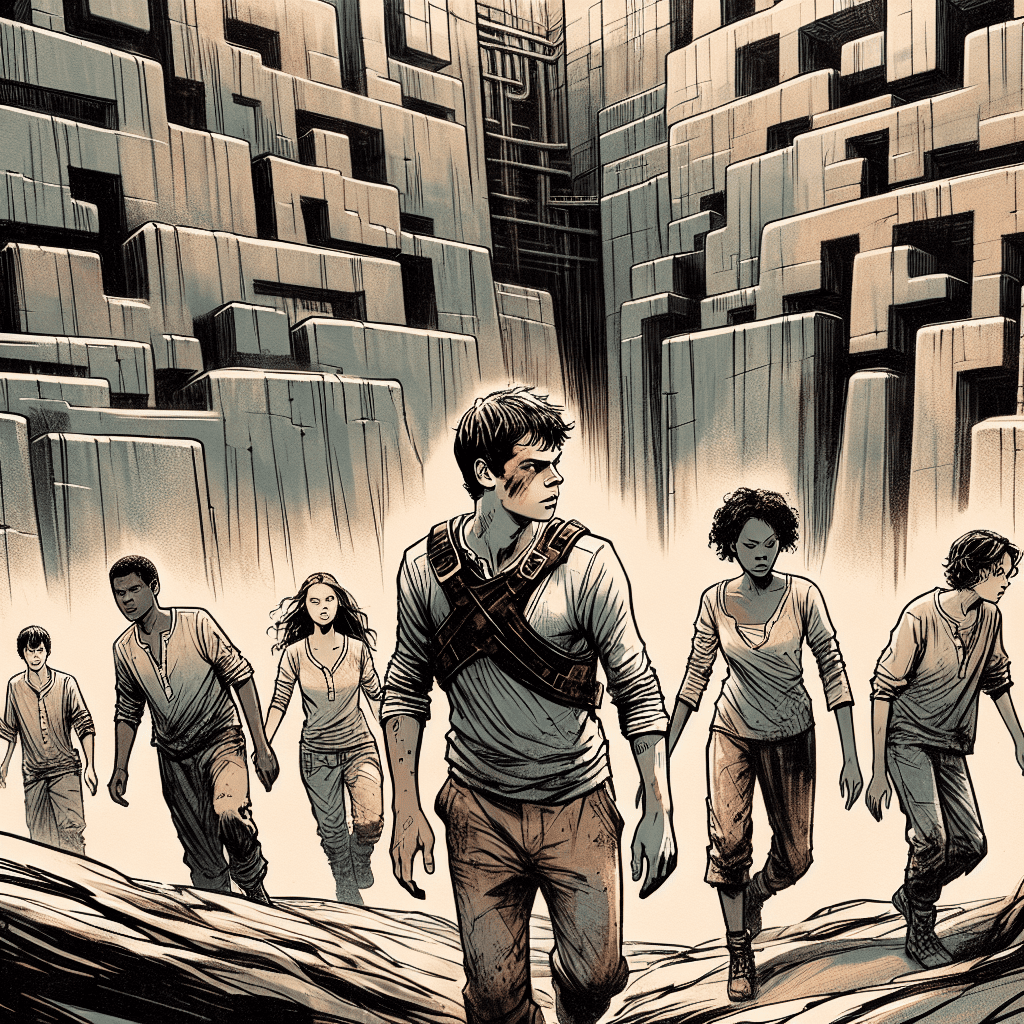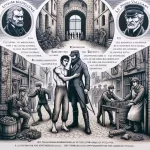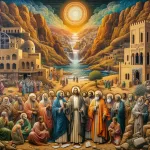-
Table of Contents
“Survival, friendship, and the quest for truth in a world of shifting mazes.”
The Maze Runner book series, authored by James Dashner, is a gripping dystopian saga that follows a group of teenagers trapped in a mysterious and ever-changing maze. The story centers around Thomas, who awakens in the Glade with no memory of his past, alongside other boys who have formed a rudimentary society. As they navigate the challenges of the maze and confront terrifying creatures known as Grievers, themes of survival, friendship, and the quest for identity emerge. The series explores the complexities of human nature, the struggle against oppressive systems, and the importance of teamwork and resilience. Key characters, including Thomas, Teresa, Minho, and Gally, each play pivotal roles in unraveling the mysteries of their environment and confronting the forces that control their fate. Through its fast-paced narrative and thought-provoking themes, The Maze Runner series captivates readers and invites them to ponder the implications of choice, memory, and the essence of humanity.
Overview of The Maze Runner Series
The Maze Runner series, authored by James Dashner, is a captivating dystopian saga that unfolds in a world fraught with peril and uncertainty. The narrative centers around a group of teenagers who find themselves trapped in a mysterious and ever-changing maze, devoid of any recollection of their past lives. This initial premise sets the stage for a gripping exploration of survival, friendship, and the quest for identity. The series comprises four main books: “The Maze Runner,” “The Scorch Trials,” “The Death Cure,” and a prequel titled “The Kill Order.” Each installment builds upon the last, weaving a complex tapestry of intrigue and suspense that keeps readers engaged from start to finish.
At the heart of the series is Thomas, the protagonist who arrives in the Glade, the central hub of the maze, with no memory of who he is or how he got there. As he navigates the challenges of the Glade, he encounters a diverse cast of characters, each with their own unique traits and backgrounds. Among them are Newt, the second-in-command who embodies leadership and compassion; Minho, the skilled Keeper of the Runners who is resourceful and brave; and Teresa, the only girl to arrive in the Glade, whose connection to Thomas adds layers of complexity to the narrative. The relationships among these characters are pivotal, as they highlight themes of loyalty, sacrifice, and the struggle for autonomy in a controlled environment.
As the story progresses, the characters face increasingly daunting obstacles, including the terrifying Grievers—mechanical creatures that patrol the maze at night. The maze itself serves as a metaphor for the challenges of adolescence and the journey toward self-discovery. The ever-shifting walls of the maze symbolize the unpredictable nature of life, while the characters’ attempts to escape reflect their desire for freedom and understanding. This theme of escape is not merely physical; it also encompasses the emotional and psychological barriers that the characters must confront.
Transitioning from the maze to the broader world, the subsequent books delve into the aftermath of their escape and the harsh realities of a post-apocalyptic society ravaged by a deadly virus known as the Flare. The Scorch Trials introduces readers to a desolate landscape where survival becomes even more precarious. Here, the characters must grapple with betrayal and the moral dilemmas posed by their circumstances. The exploration of human resilience in the face of adversity is a recurring theme throughout the series, as the characters are forced to make difficult choices that test their values and friendships.
In the final installment, The Death Cure, the stakes reach their zenith as Thomas and his friends confront the organization responsible for their suffering, WICKED. The series culminates in a profound examination of the ethics of experimentation and the cost of survival. Ultimately, the Maze Runner series is not just a tale of adventure; it is a poignant reflection on the complexities of human nature, the bonds of friendship, and the relentless pursuit of truth. Through its richly developed characters and intricate plotlines, the series invites readers to ponder the essence of humanity in a world where trust is scarce and hope is a fragile commodity. As such, it leaves an indelible mark on the landscape of young adult literature, resonating with themes that are both timeless and universally relevant.
Key Themes in The Maze Runner
The Maze Runner book series, authored by James Dashner, presents a compelling narrative that intertwines various themes, each contributing to the overarching story of survival, identity, and the human condition. One of the most prominent themes is the struggle for survival, which is vividly illustrated through the experiences of the Gladers, a group of teenagers trapped in a mysterious and ever-changing maze. This theme is not merely about physical survival; it also encompasses the psychological and emotional challenges faced by the characters as they navigate their harsh environment. The constant threat of the Grievers, monstrous creatures that patrol the maze at night, serves as a catalyst for the characters to confront their fears and develop resilience.
In addition to survival, the theme of friendship and camaraderie plays a crucial role in the series. The relationships formed among the Gladers are essential for their emotional well-being and collective strength. As they face the trials of the maze together, they learn to trust one another, share burdens, and celebrate victories, no matter how small. This theme underscores the importance of human connection in overcoming adversity, suggesting that solidarity can be a powerful tool in the face of insurmountable odds. The bonds formed in the Glade highlight the idea that, even in the most dire circumstances, individuals can find solace and strength in one another.
Another significant theme is the quest for identity and self-discovery. The characters, particularly Thomas, grapple with their memories and pasts, which have been erased as part of the experiment conducted by WICKED, the organization behind the maze. This loss of memory raises profound questions about the nature of identity: Are we defined by our memories, or do our actions shape who we are? As the characters strive to uncover their pasts and understand their roles within the maze, they embark on a journey of self-exploration that ultimately leads to personal growth and transformation. This theme resonates with readers, as it reflects the universal human experience of seeking purpose and understanding in a complex world.
Moreover, the series delves into the theme of sacrifice and moral dilemmas. The characters are frequently faced with choices that test their values and ethics, forcing them to weigh their own survival against the well-being of others. This theme is particularly evident in the character of Minho, who often prioritizes the safety of his friends over his own. Such decisions highlight the complexities of human nature and the moral ambiguities that arise in desperate situations. The exploration of sacrifice serves to deepen the narrative, prompting readers to reflect on their own values and the lengths they would go to protect those they care about.
Lastly, the theme of hope and perseverance is woven throughout the series. Despite the seemingly insurmountable challenges faced by the Gladers, they continually strive for freedom and a better future. This relentless pursuit of hope serves as a beacon, guiding them through despair and uncertainty. The series ultimately conveys a powerful message about the resilience of the human spirit, suggesting that even in the darkest of times, hope can illuminate the path forward. In conclusion, The Maze Runner series intricately weaves together themes of survival, friendship, identity, sacrifice, and hope, creating a rich tapestry that resonates with readers and invites them to reflect on their own lives and choices.
Character Analysis of Thomas
In the “Maze Runner” book series, Thomas emerges as a pivotal character whose journey encapsulates the essence of courage, resilience, and the quest for identity. From the moment he arrives in the Glade, devoid of memories and understanding, Thomas embodies the struggle of self-discovery amidst chaos. His initial confusion and fear are relatable, drawing readers into his plight as he grapples with the unfamiliar environment and the rules that govern the Gladers’ existence. This disorientation serves as a foundation for his character development, as he gradually transforms from a passive participant into a proactive leader.
As the narrative unfolds, Thomas’s innate curiosity and determination set him apart from his peers. Unlike many of the other Gladers, who have accepted their fate within the confines of the Maze, Thomas is driven by an insatiable desire to uncover the truth. This quest for knowledge not only propels the plot forward but also highlights a significant theme of the series: the importance of questioning authority and seeking answers. Thomas’s willingness to challenge the status quo is evident when he volunteers to become a Runner, a role fraught with danger yet essential for understanding the Maze’s complexities. His bravery in facing the unknown reflects a deeper philosophical inquiry into the nature of fear and the human spirit’s capacity to confront it.
Moreover, Thomas’s relationships with other characters further enrich his character arc. His bond with Teresa, the only girl to arrive in the Glade, introduces an emotional layer to his journey. Their connection, marked by a shared history that neither fully comprehends, serves as a catalyst for Thomas’s growth. As they navigate the challenges posed by the Maze and the sinister forces behind it, their relationship evolves, illustrating themes of trust, loyalty, and the power of human connection. Additionally, Thomas’s interactions with Alby, Newt, and Minho reveal his capacity for empathy and leadership. He learns to balance his instincts with the needs of the group, showcasing his development from an individualistic mindset to one that values collaboration and community.
As the series progresses, Thomas’s character is tested in increasingly dire circumstances. The trials he faces not only challenge his physical abilities but also force him to confront moral dilemmas that question the very fabric of his identity. The ethical implications of survival, sacrifice, and the greater good become central to his character as he grapples with the consequences of his decisions. This internal conflict is particularly evident in moments of crisis, where Thomas must weigh his instincts against the welfare of his friends, ultimately reinforcing the theme of personal responsibility.
In conclusion, Thomas’s character serves as a lens through which readers can explore the broader themes of the “Maze Runner” series. His evolution from a confused newcomer to a decisive leader encapsulates the journey of self-discovery and the importance of resilience in the face of adversity. Through his relationships and moral challenges, Thomas embodies the struggle for identity and the quest for truth, making him a compelling figure whose experiences resonate with readers on multiple levels. As he navigates the complexities of the Maze and the world beyond, Thomas’s story invites reflection on the nature of courage, friendship, and the enduring human spirit.
The Role of Friendship in The Maze Runner
In “The Maze Runner” series, friendship emerges as a pivotal theme that significantly influences the characters’ development and the narrative’s progression. The bonds formed among the Gladers serve not only as a source of emotional support but also as a crucial element in their survival within the treacherous environment of the Maze. As the story unfolds, the relationships between characters reveal the complexities of human connection, illustrating how friendship can both empower and complicate their experiences.
At the heart of the series is Thomas, the protagonist, whose arrival in the Glade marks the beginning of a transformative journey. Initially, Thomas is an outsider, grappling with confusion and fear. However, as he begins to forge friendships with other Gladers, particularly with characters like Minho and Newt, he discovers a sense of belonging and purpose. These relationships are instrumental in helping him navigate the challenges posed by the Maze and the dangers that lurk beyond its walls. The camaraderie among the Gladers fosters a spirit of teamwork, enabling them to devise strategies to confront the Grievers and ultimately seek an escape from their confinement.
Moreover, the friendships in “The Maze Runner” are characterized by loyalty and sacrifice. The characters often face moral dilemmas that test their bonds, forcing them to make difficult choices for the sake of their friends. For instance, when one of their own is in danger, the Gladers demonstrate unwavering support, showcasing the depth of their commitment to one another. This loyalty is particularly evident in the relationship between Thomas and Minho, who share a mutual respect and understanding that transcends the challenges they face. Their friendship not only strengthens their resolve but also highlights the importance of trust in overcoming adversity.
As the series progresses, the theme of friendship evolves, particularly in the face of betrayal and loss. The introduction of new characters, such as Teresa, complicates the dynamics within the group, leading to moments of tension and conflict. Teresa’s arrival challenges the established friendships, as her connection to Thomas brings both hope and uncertainty. This complexity underscores the idea that friendship is not always straightforward; it can be fraught with misunderstandings and emotional turmoil. Nevertheless, the characters learn to navigate these challenges, ultimately reinforcing their bonds and demonstrating resilience in the face of adversity.
Furthermore, the series explores the idea that friendship can be a source of strength in moments of despair. As the Gladers confront the harsh realities of their situation, their relationships provide a sense of hope and motivation. The shared experiences of fear, loss, and triumph create a profound sense of unity among them. This collective strength becomes a driving force in their quest for freedom, illustrating how friendship can inspire individuals to rise above their circumstances.
In conclusion, the role of friendship in “The Maze Runner” series is multifaceted, serving as a foundation for character development and a catalyst for action. Through the bonds formed among the Gladers, the narrative emphasizes the significance of loyalty, sacrifice, and resilience. As they navigate the complexities of their relationships, the characters learn that true friendship can empower them to confront their fears and ultimately strive for a better future. In this way, friendship not only shapes their identities but also plays a crucial role in their journey toward liberation from the Maze.
Dystopian Elements in The Maze Runner
The Maze Runner series, authored by James Dashner, is a compelling exploration of dystopian elements that resonate deeply with contemporary societal concerns. Set in a post-apocalyptic world, the narrative unfolds in a mysterious and perilous environment known as the Glade, surrounded by an ever-shifting maze. This setting serves as a microcosm of a larger, decaying society, reflecting themes of survival, control, and the loss of individuality. The Glade, with its rigid structure and the ever-present threat of the maze, symbolizes the oppressive nature of dystopian regimes, where freedom is curtailed, and individuals are subjected to the whims of a higher authority.
One of the most striking dystopian elements in The Maze Runner is the manipulation of memory and identity. The characters, particularly Thomas, awaken in the Glade with no recollection of their past lives, stripped of their identities and forced to adapt to a new reality. This amnesia serves as a powerful narrative device, emphasizing the theme of dehumanization prevalent in dystopian literature. The loss of memory not only highlights the fragility of identity but also raises questions about the nature of humanity itself. As the characters navigate their new environment, they grapple with the implications of their forgotten pasts, ultimately seeking to reclaim their identities in a world that seeks to define them.
Moreover, the series delves into the concept of societal control through the actions of the creators, known as WCKD (World Catastrophe Killzone Department). WCKD embodies the archetype of a dystopian authority that prioritizes its agenda over individual lives. The organization’s experiments on the Gladers, subjecting them to the dangers of the maze and the Grievers, illustrate the extent to which power can corrupt and dehumanize. This manipulation of the characters for the sake of a greater good raises ethical questions about the morality of sacrificing a few for the benefit of many, a common theme in dystopian narratives. The Gladers’ struggle against WCKD’s control reflects a broader commentary on resistance and the fight for autonomy in the face of oppressive systems.
In addition to the themes of control and identity, The Maze Runner series also explores the impact of technology on society. The maze itself, a complex and ever-changing structure, represents the advanced yet perilous nature of technological progress. While technology has the potential to enhance human life, in this narrative, it serves as a tool of oppression and manipulation. The Grievers, bio-mechanical creatures that patrol the maze, further exemplify the dangers of unchecked technological advancement. They embody the fear of losing control over creations that were initially intended to serve humanity but ultimately become instruments of terror.
Furthermore, the series addresses the theme of survival in a harsh and unforgiving world. The Gladers must rely on their instincts, intelligence, and teamwork to navigate the challenges posed by the maze and the threats within it. This struggle for survival not only highlights the resilience of the human spirit but also underscores the importance of community in overcoming adversity. As the characters form bonds and alliances, they demonstrate that hope and solidarity can flourish even in the bleakest of circumstances.
In conclusion, The Maze Runner series intricately weaves together various dystopian elements, including the manipulation of memory, societal control, the impact of technology, and the struggle for survival. Through its rich narrative and complex characters, the series invites readers to reflect on the implications of these themes in their own lives, ultimately serving as a cautionary tale about the potential consequences of a world devoid of empathy and individuality.
The Evolution of Characters Throughout the Series
The Maze Runner book series, authored by James Dashner, presents a compelling narrative that intricately weaves together themes of survival, friendship, and the quest for identity. As the story unfolds across the trilogy, the evolution of its characters becomes a focal point, illustrating their growth in response to the harrowing challenges they face. Initially introduced in a state of confusion and fear, the characters gradually develop into resilient individuals, each shaped by their experiences within the treacherous environments of the Glade and beyond.
At the outset, Thomas, the protagonist, emerges in the Glade with no memories of his past, embodying the archetype of the reluctant hero. His initial naivety is palpable as he grapples with the bewildering rules of the Glade and the ever-present threat of the Maze. However, as the narrative progresses, Thomas transforms from a passive participant into a decisive leader. His determination to uncover the truth behind the Maze and the organization known as WICKED propels him into a position of authority among the Gladers. This evolution is not merely a function of circumstance; it reflects his innate qualities of bravery and intelligence, which become more pronounced as he confronts the moral complexities of their situation.
Similarly, other characters undergo significant transformations throughout the series. Minho, the Keeper of the Runners, initially appears as a tough and somewhat aloof figure, focused primarily on survival. However, as he and Thomas navigate the dangers of the Maze and later the trials set by WICKED, Minho reveals layers of loyalty and camaraderie. His relationship with Thomas deepens, showcasing a bond forged through shared adversity. This evolution highlights the theme of friendship, emphasizing how trust and collaboration are essential for overcoming insurmountable odds.
In contrast, Teresa, the only female Glader, presents a unique perspective on character evolution. Initially portrayed as a mysterious figure with a connection to Thomas, her character arc explores themes of identity and agency. As the series progresses, Teresa grapples with her role within the group and the implications of her past actions. Her journey reflects the struggle for self-definition in a world where external forces seek to manipulate individuals for their own ends. This internal conflict adds depth to her character, illustrating that evolution is not solely about external challenges but also about reconciling one’s identity with the choices made.
Moreover, the antagonistic figures, such as Gally and WICKED’s leaders, also experience notable transformations. Gally, who initially embodies the harsh realities of survival in the Glade, evolves into a more complex character as the series unfolds. His motivations and actions are revealed to be influenced by fear and a desire for control, prompting readers to reconsider the nature of villainy. This complexity enriches the narrative, suggesting that characters are not simply good or evil but are shaped by their circumstances and choices.
Ultimately, the evolution of characters in The Maze Runner series serves as a microcosm of the broader themes of resilience and moral ambiguity. As they navigate the labyrinthine challenges presented by their environment, each character’s journey reflects a quest for understanding and purpose. Through their trials, they not only confront external threats but also engage in profound internal struggles, making their evolution a central element of the series’ enduring appeal. In this way, Dashner crafts a narrative that resonates with readers, inviting them to reflect on their own journeys of growth and self-discovery.
Q&A
1. **What is the main premise of The Maze Runner series?**
The Maze Runner series follows a group of teenagers who wake up in a mysterious maze with no memory of their past. They must navigate the maze and uncover the truth behind their captivity while facing various challenges and dangers.
2. **Who is the protagonist of the series?**
Thomas is the main protagonist of the series. He is a determined and courageous teenager who takes on a leadership role among the Gladers as they seek to escape the maze and understand their situation.
3. **What are the key themes explored in The Maze Runner series?**
Key themes include survival, friendship, the struggle for identity, the consequences of choices, and the moral implications of scientific experimentation.
4. **Who are the main characters in The Maze Runner series?**
Main characters include Thomas, Teresa (the only girl in the Glade), Minho (the Keeper of the Runners), Newt (the second-in-command), and Gally (a rival leader among the Gladers).
5. **What is the significance of the maze in the story?**
The maze serves as a test created by WCKD (World Catastrophe Killzone Department) to evaluate the Gladers’ problem-solving abilities and resilience in the face of adversity, reflecting broader themes of control and manipulation.
6. **How does the series conclude?**
The series concludes with the revelation of the truth behind WCKD and the trials the characters faced. The final book, “The Death Cure,” addresses the characters’ fight against WCKD and their quest for freedom, ultimately leading to significant sacrifices and resolutions for the main characters.The Maze Runner book series, authored by James Dashner, presents a gripping narrative centered around a group of teenagers trapped in a mysterious maze, exploring themes of survival, friendship, and the quest for identity. The series delves into the complexities of human nature, the moral dilemmas faced in dire situations, and the impact of memory and knowledge on personal growth. Key characters, such as Thomas, Teresa, and Minho, embody resilience and courage as they navigate the challenges posed by the maze and the greater world beyond it. Ultimately, the series highlights the importance of unity and the struggle against oppressive forces, leaving readers with a thought-provoking commentary on the human experience in the face of adversity.




